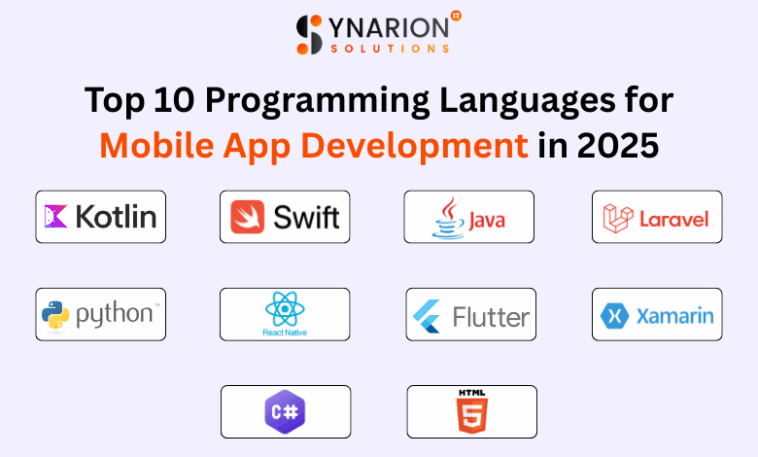Introduction
Mobile app development has come a long way, and with the rapid evolution of technology, developers need to stay ahead of the curve. In 2025, the mobile app landscape is more diverse and complex than ever. Choosing the right programming language is critical for creating efficient, user-friendly, and high-performance mobile applications. Whether you’re looking for a cross-platform solution or developing for a specific platform, understanding the strengths and weaknesses of various programming languages is essential. Below, we explore the top 10 programming languages for mobile app development in 2025, which are widely used by developers and mobile app development companies worldwide, including a leading Mobile App Development Company in India.
#1. Kotlin
Kotlin continues to reign supreme for Android app development in 2025. As the preferred language for building Android applications, Kotlin’s concise syntax, null-safety features, and seamless integration with Java make it an indispensable tool for developers. It is officially supported by Google for Android app development, which ensures regular updates and robust documentation. Kotlin’s interoperability with Java also allows developers to use both languages within the same project, making it a versatile choice for developers working on Android apps.
#2. Swift
For iOS app development, Swift is the go-to language in 2025. Developed by Apple, Swift is a modern, easy-to-learn, and powerful programming language that has quickly replaced Objective-C as the primary choice for iOS app development. Its speed, safety features, and active support from Apple ensure that Swift remains a top contender. Swift is ideal for building fast, responsive, and smooth iOS apps, making it an essential language for developers targeting Apple’s ecosystem.
#3. Java
Although newer languages like Kotlin and Swift are making waves, Java remains a staple in mobile app development, especially for Android. Java’s portability, extensive libraries, and a massive community of developers ensure its place in the industry. Many legacy Android apps are still built in Java, and it is an excellent choice for developers working on long-term projects where backward compatibility is crucial.
#4. Laravel
Laravel is a PHP framework that has found its place in the mobile app development landscape due to its robust back-end capabilities. Laravel is primarily used for server-side scripting, but it plays an essential role in building the back end of mobile applications. The framework’s ease of use, extensive documentation, and security features make it ideal for developing scalable and secure APIs for mobile apps
#5. Python
Python is becoming increasingly popular in mobile app development due to its simplicity and versatility. While traditionally used for backend development, Python’s frameworks like Kivy and BeeWare allow developers to build cross-platform mobile apps. Python’s vast ecosystem of libraries and frameworks also makes it ideal for rapid prototyping and MVP (Minimum Viable Product) development. Developers at mobile app development companies, including those in India, use Python to create apps that require complex data processing, AI, or machine learning capabilities.
#6. React Native
React Native, developed by Facebook, is one of the most popular frameworks for building cross-platform mobile apps. It allows developers to write code in JavaScript and render it to both iOS and Android platforms. In 2025, React Native’s ability to reuse code across multiple platforms makes it an efficient solution for mobile app development. With a vibrant community and regular updates, React Native continues to be a top choice for companies looking to build apps with a single codebase for both platforms.
#7. Flutter
Flutter, Google’s open-source UI toolkit, has gained significant popularity among developers for creating natively compiled applications for mobile, web, and desktop from a single codebase. Flutter uses Dart as its programming language, which allows for fast development cycles, rich UIs, and high performance. In 2025, Flutter continues to stand out for its expressive UI, quick performance, and strong community support. It is especially favored for creating apps that require a high level of customization and smooth animations.
#8. Xamarin
Xamarin is a cross-platform mobile app development framework owned by Microsoft. It allows developers to write code in C# and run it on both iOS and Android platforms. Xamarin provides native-like performance and access to native APIs, which makes it ideal for building high-performance mobile apps. As a mature framework, Xamarin is favored by developers working in the Microsoft ecosystem or companies looking to integrate mobile apps with enterprise-level systems.
#9. C#
C# is a versatile, object-oriented language developed by Microsoft. It is widely used for developing cross-platform mobile applications, especially when combined with frameworks like Xamarin or Unity (for game development). C#’s robust libraries, integration with the .NET ecosystem, and strong performance make it an attractive option for mobile app developers. In 2025, C# continues to be used by a large number of developers, especially in enterprise mobile app development, game development, and apps that require complex algorithms and graphics.
#10. HTML5
HTML5, along with CSS and JavaScript, is a foundation for building web apps that can run on mobile devices. HTML5-based mobile web apps offer a seamless experience without needing to be installed on the device. HTML5’s responsive design capabilities allow developers to create applications that work across multiple devices and screen sizes. While not a traditional choice for building native apps, HTML5 is an excellent option for mobile app development companies targeting lightweight apps or web apps that need to function across platforms without needing to rely on app stores.
Conclusion
As we move into 2025, the landscape of mobile app development continues to evolve with new tools and languages emerging. The choice of programming language plays a pivotal role in the success of an app, and understanding the strengths and weaknesses of each option is essential for developers. Whether you are working with a Mobile App Development Company in India or a global tech firm, selecting the right language will ensure that your app is scalable, performant, and capable of delivering an exceptional user experience.
From Kotlin and Swift for native Android and iOS development to Flutter, React Native, and Xamarin for cross-platform apps, the programming languages available today provide a variety of solutions to meet different app development needs. Each language offers unique features and advantages, so developers must consider the app’s requirements, platform, and future scalability when making their choice.
This post was created with our nice and easy submission form. Create your post!





